Authored by Tara McCoy, CHC
If there were such a thing as a panacea in the wellness world, I’d place my bet on optimizing circadian rhythms by getting appropriate exposure to light and dark. In ancient forms of medicine (such as Greco-Roman Medicine and Traditional Chinese Medicine), there was a heavy emphasis on Nature as healer and physicians recommended aligning with nature as a disease cure. Within modern biomedicine, extolling the healing powers of nature has largely fallen out of fashion. But recently, this theme is beginning to crop up again in medical literature. This isn’t some outdated, sentimental notion after all, but rather an entire field of science known as chronobiology. Chronobiology is a branch of biology that studies how our body's natural cycles—mental, physical and emotional—are affected by solar and lunar rhythms. Our physiology has evolved to function optimally when aligned with natural rhythms of light-dark. Disrupted circadian rhythms are being correlated with a myriad of illnesses such as mood disorders, metabolic issues, cardiovascular disease, obesity, cancer, and menstrual disruptions. And unfortunately, this doesn’t appear to be a part of our physiology we can override or “hack”. A lack of adequate bright light during the day or excessive exposure to light at night both have consequences. In an era when it’s increasingly more tempting to live out of sync with light-dark cycles, aligning with the rhythms of nature may be one of our most potent forms of preventive medicine.
SO, what exactly disrupts our “inner clocks”? Our circadian clock is primarily set by exposure to light and dark. For my science lovers out there, let me explain how this works physiologically. In our brains, the suprachiasmatic nucleus (SCN) keeps track of light-dark signals from the optic nerve and triggers hormonal and behavioral outputs accordingly. The reduction of light at night is detected by our SCN and triggers the release of melatonin from our pineal glands, which causes sleepiness.
For most of our evolutionary history, as the sun went down we were no longer exposed to bright light (more specifically light in the blue spectrum) so the current problem lies in an evolutionary mismatch from what our bodies have evolved to expect versus recent technological developments. With the invention of the lightbulb in 1879 and the technological revolution, we have unprecedented inputs of light at night ( or LAN, as it is called in the scientific literature) that lead to circadian disruption. The use of artificial light and devices after dark disrupts the environmental cue and our levels of melatonin are abnormally suppressed which reduces both the quality of sleep and the ability to fall asleep. This is problematic for reasons beyond melatonin’s impact on sleep quality. It is less commonly known that beyond its influence on sleep, melatonin is also an incredibly potent anti-inflammatory, antioxidant, immunomodulating and oncostatic hormone. It’s currently being widely researched because of its potential anti-cancer effects. So basically, every hour after dark that you are exposing yourself to blue light, you’re decreasing the levels of this powerfully health-promoting hormone you’re exposed to. Or in simpler terms, as far as our physiology is concerned, exposure to adequate darkness each day is a form of vital medicine. The official recommendation is maintaining a window of 9-10 hours of darkness each 24-hour cycle. For most of us this would mean an hour or two before bed we’d stop looking at screens (T.V., computers), devices (phones, iPads) AND dim the lights or use lights in the red spectrum.
Secondary inputs that influence our circadian clock are eating patterns, exercise, social inputs, and levels of stress hormones such as cortisol. The most powerful secondary input is meal timing or more precisely, cycles of feeding and fasting. For optimal health, our meal timings would correspond with light/dark cycles (a.k.a no late night eating). Limiting feeding to daytime hours and increasing periods of fasting at night does the body good. This doesn’t need to be extreme. See my recommendations below for the details.
HOW TO RESET YOUR CIRCADIAN RHYTHMS FOR OPTIMAL HEALTH:
SO, what exactly disrupts our “inner clocks”? Our circadian clock is primarily set by exposure to light and dark. For my science lovers out there, let me explain how this works physiologically. In our brains, the suprachiasmatic nucleus (SCN) keeps track of light-dark signals from the optic nerve and triggers hormonal and behavioral outputs accordingly. The reduction of light at night is detected by our SCN and triggers the release of melatonin from our pineal glands, which causes sleepiness.
For most of our evolutionary history, as the sun went down we were no longer exposed to bright light (more specifically light in the blue spectrum) so the current problem lies in an evolutionary mismatch from what our bodies have evolved to expect versus recent technological developments. With the invention of the lightbulb in 1879 and the technological revolution, we have unprecedented inputs of light at night ( or LAN, as it is called in the scientific literature) that lead to circadian disruption. The use of artificial light and devices after dark disrupts the environmental cue and our levels of melatonin are abnormally suppressed which reduces both the quality of sleep and the ability to fall asleep. This is problematic for reasons beyond melatonin’s impact on sleep quality. It is less commonly known that beyond its influence on sleep, melatonin is also an incredibly potent anti-inflammatory, antioxidant, immunomodulating and oncostatic hormone. It’s currently being widely researched because of its potential anti-cancer effects. So basically, every hour after dark that you are exposing yourself to blue light, you’re decreasing the levels of this powerfully health-promoting hormone you’re exposed to. Or in simpler terms, as far as our physiology is concerned, exposure to adequate darkness each day is a form of vital medicine. The official recommendation is maintaining a window of 9-10 hours of darkness each 24-hour cycle. For most of us this would mean an hour or two before bed we’d stop looking at screens (T.V., computers), devices (phones, iPads) AND dim the lights or use lights in the red spectrum.
Secondary inputs that influence our circadian clock are eating patterns, exercise, social inputs, and levels of stress hormones such as cortisol. The most powerful secondary input is meal timing or more precisely, cycles of feeding and fasting. For optimal health, our meal timings would correspond with light/dark cycles (a.k.a no late night eating). Limiting feeding to daytime hours and increasing periods of fasting at night does the body good. This doesn’t need to be extreme. See my recommendations below for the details.
HOW TO RESET YOUR CIRCADIAN RHYTHMS FOR OPTIMAL HEALTH:
- Expose yourself to natural light first thing in the morning. Circadian alignment starts as soon as you wake up. Exposure to natural light, ideally in the morning before 10:30 am, aligns your circadian rhythm and has been proven to result in better sleep at night. The best way to do this is to get outside in the morning, without sunglasses, for at least 10 minutes (cloudy days included). At the very least, open the shades and let natural light into your living space. If it is not possible to get outside, considering using a light box of at least 10,000 lux.
- Exercise in the morning. By getting some gentle movement in the morning, even 5-10 minutes counts, you optimize your circadian rhythm by appropriately setting your cortisol curve. Exercise helps ensure a spike of cortisol in the morning which leads to lower levels at night, which improves sleep quality and melatonin levels.
- Avoid screens AT LEAST 1 hour before bed. Again, think of darkness as medicine. Darkness leads to the release of melatonin and melatonin increases sleep quality and reduces chronic inflammation. The most powerful way to ensure optimal levels of melatonin is to set a digital sunset each night. This means no longer looking at your phone, screens, Kindle, etc. after a certain time each night. As a compromise, you can download f.lux on your computer and use Nightshift (if you have an iPhone 5 or higher) which limits the blue light emitted from your computer and phone. Another option is wearing really dorky blue light blocking orange sunglasses at night.
- Make sure your bedroom is completely dark. Using an eye mask is a great start but it been discovered that your skin has photoreceptors which detect light and can disrupt your melatonin levels, so it's important that your room is completely dark. Invest in blackout curtains and get all devices out of the bedroom. For extra insurance, consider getting a nightlight in the red spectrum for your bathroom and hallway so you don’t have to turn on the blue-light emitting overhead light if you wake up in the middle of the night.
- Stop eating or drinking alcohol at least 3 hours before bedtime. Late night alcohol or eating disrupt sleep architecture. A lot of great functional medicine practitioners recommend a 12-hour window between dinner and breakfast, or simply stopping eating 3 hours before bedtime. Alcohol may help you fall asleep but it disrupts sleep quality and depth so it is best avoided near bedtime.
- Ritual and consistency are key. Going to bed and getting up at roughly the same time each day entrains your circadian clock. Ideally, go to bed between 10-11p and wake up around 7 am. Create sleep rituals that help you wind down at night and do your best to stick to them.
- Start Earthing. One of the best ways to reset our circadian rhythms is to get barefoot contact with the Earth aka Earthing or Grounding. This is a slightly unconventional recommendation that I’ve written off in the past as too hippy, even for me. But I’ve become convinced after reading some amazing journal articles on the benefits. According to Chevalier et al., “Mounting evidence suggests that the Earth's negative potential can create a stable internal bioelectrical environment for the normal functioning of all body systems. Moreover, oscillations of the intensity of the Earth's potential may be important for setting the biological clocks regulating diurnal body rhythms, such as cortisol secretion”. From a practical standpoint, the recommendation is “barefoot sessions” (weather-permitting) for as little as 30-40 minutes daily. There are also some emerging grounding technologies that give you the same benefits without the barefoot time. For more on Earthing, visit this website.


 RSS Feed
RSS Feed